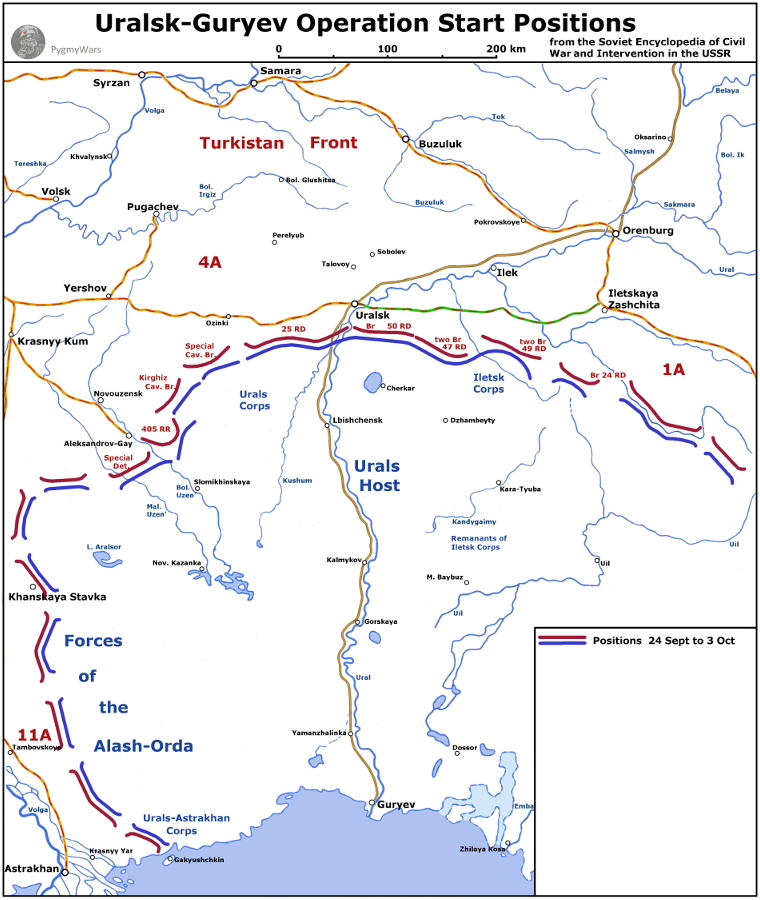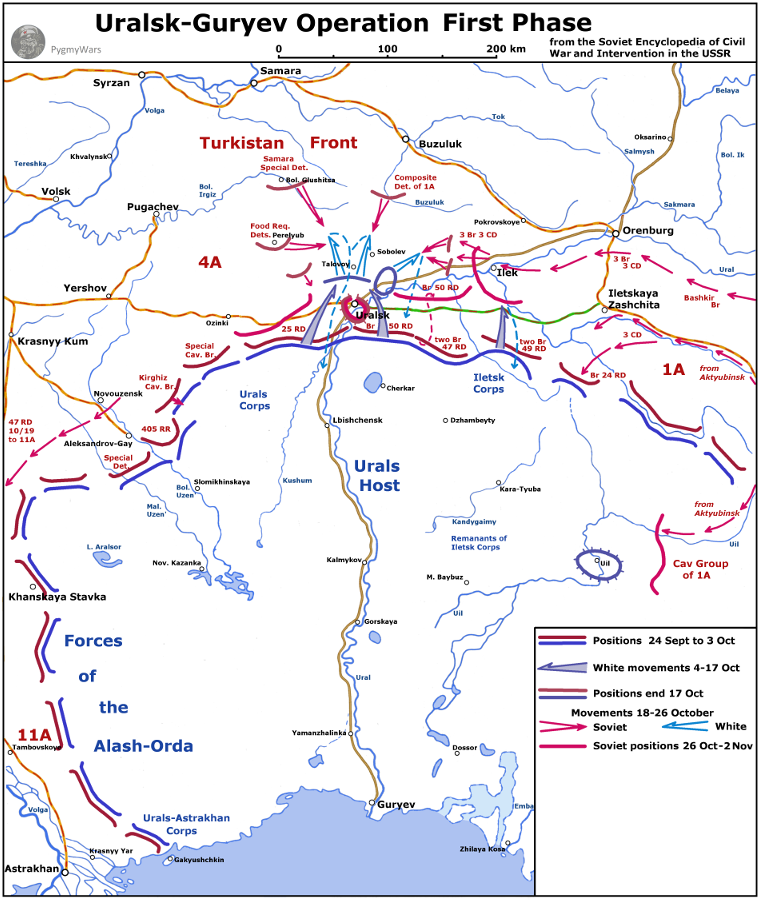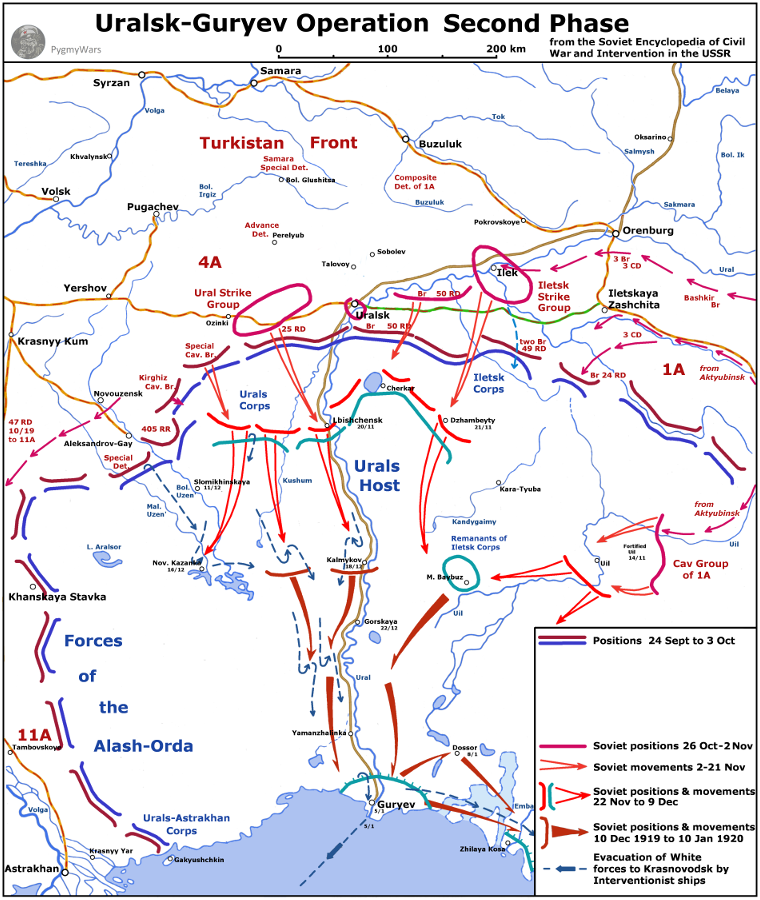
Uralsk-Guryev Operation
In September 1919 the Orenburg Cossacks were defeated, and what remained of their forces were retiring, mostly eastwards. This left the Urals Cossacks and the western branch of the anti-Bolshevik Kazakhs (Alash-Orda) cut off from the other White forces. The Soviets decided to concentrate their forces to defeat them.
Starting Soviet Forces
Facing the Urals Host forces was the Turkestan Front (commander Mikhail Frunze, RVS - B.B. Kuibyshev, Sh.Z. Eliava, from December 13, A.M. D'yakonov) with the 1st, 4th and 11th Armies.
First Army
The Soviet Encyclopedia of the Civil War and Intervention in the USSR ("the Encyclopdedia") gives First Army (commander G. V. Zinoviev) for the portion facing the Ural Cossacks as made up of: two brigades of 49th Rifle Division, a brigade of 3rd Turkestan Cavalry Division, and 436th Rifle Regiment, for a total of 4,600 bayonets, 1,500 sabres, about 15 guns, 120 machine guns.
But the map in the Encyclopedia also shows 1st Army with a brigade of the 24th Rifle Division as well, and likely some other small cavalry units in the steppes.
These forces were lined up some 50 km south of the Uralsk-Iletsk-Tashkent rail line, extending about 200 km east to west centred on Iletsk, with a light covering force in the steppes to the East.
The remainder of the army was proceeding south down the Orenburg-Tashkent railway.
Fourth Army
The Encyclopedia gives Fourth Army (commander V. S. Lazarevich , from 8 October, G. K. Voskanov) as including: 25th Rifle Division, one brigade of 40th Rifle Division, two brigades of 47th Rifle Divisions, and a Kirghiz Cavalry Brigade, for a total of about 15,000 bayonets, 2,200 sabres, about 70 guns, 270 machine guns.
The map in the Encyclopedia however also shows in the 4th Army area: the 405th Rifle Regiment, a Special Detachment, a Special Mounted Brigade, and a brigade of the 50th Rifle Division.
The army was concentrated in a strip just south of Uralsk and extending 200 km from east to west, with a light covering force in the steppes to the west.
The forces of the Fortified Area of Uralsk were also in this sector, although not part of 4th Army proper.
Eleventh Army
The Encyclopedia gives 11th Army with: 34th Rifle Division, 50th Rifle Division, 7th Cavalry Division, and 1st Cavalry Division (to December 1920).
The portion facing the Urals was about 2,500 bayonets, 1,500 sabres, 16 guns, 100 machine guns, mostly in the Krasnyy Yar area.
The rest faced Denikin to the west and Wrangel in the Tsartisyn area.
 Clicking on the map will bring up a higher resolution version.
Clicking on the map will bring up a higher resolution version.
White Forces
The Independent Ural Army (1st Urals and 11th Iletsky Corps) had over 4,00 bayonets, 10,500 sabres, 45 guns and 150 machine guns.
There was a Ural-Astrakhan Corps, composed of Astrakhan Cossacks and various non-Cossacks, facing Astrakhan city, near Krasnyy Yar, that are likely not included in those numbers.
Some of the Orenburg Army had fled westwards, including both Cossack regiments and a few of Kolchak's infantry, but are never mentioned in the accounts. I presume they were the extreme right wing of the White forces.
Alash-Orda is given 9,00 bayonets, 8,600 sabres, 36 guns and 80 machine guns by the Encyclopedia for this campaign, but this is likely their entire forces, and that includes the "Eastern" portion around Semipalatinsk, which was likely the bulk of them.
The Balance
The White troops had a huge superiority in the cavalry, both in numbers and quality, which helped in the bare steppes (much of the 1,250 km front) and allowed them to move forces quickly. When they did penetrate Red lines, they were able to exploit them fully with their extra mobility. By this stage of the war the Reds had increased their cavalry numbers, but they were still only half the size of the White ones.
The Ural Host's lack of infantry, and especially quality infantry, prevented them from taking defended positions - and their inability to take Uralsk had been a serious impediment to their progress earlier in 1919.
The Reds had a superiority in technical means, such as armoured cars and aviation, although the Cossacks had built theirs up over time. The Ural host particularly suffered though with shortages of both cartridges and shells.
Plans of the Parties
The White command planned an offensive by the Ural army towards Uralsk, the usual focal point of their campaigns, while the Alash-Orda and Ural-Astrakhan Corps were to attack towards Astrakhan city. This was also intended to divert troops away from Denikin's forces, which were making some headway in the Tsaritsyn area.
Frunze's original plan, according to a 15 September order, provided for 11th Army to contain the Alash-Orda, the 4th army and right wing of the 1st Army were to strike in the general direction of Lbishchensk , throwing the Ural Army into the steppes, where they would be defeated.
The First Phase
The offensive of the Red 4th Army, which began on 24 September 1919, met with stubborn resistance from the Whites.
On October 4, the Independent Ural Army began a counter-offensive (coordinating it with the AFSR's Caucasian Army , which launched another offensive against Tsaritsyn). The Cossacks broke through the front of the 4th Army to both the west and east of Uralsk, cutting the Saratov-Uralsk and Uralsk-Orenburg railway lines and two cavalry columns - about 6,000 sabres - advanced to north of Uralsk. However the troops and worker detachments of the Uralsk Fortified Area were able to defend Uralsk city.
Reserves arrived from Saratov (likely mobilised workers, quite possibly ChON, and hastily organised food requisitioning detachments) and the regrouped troops of the 4th and 1st armies, after some fierce fighting, threw the Whites behind the Uralsk highway. By 26 October the Reds had completely removed all the small White cavalry detachments in their rear and their front was fully restored.
 Clicking on the map will bring up a higher resolution version.
Clicking on the map will bring up a higher resolution version.
Results of the First Phase
With the front now stable, Lenin demanded the allocation of part of the troops to strengthen the forces facing Wrangel. The 11th Army was transferred to the Southeast Front and the 47th Infantry Division was added to its forces in November, from the 4th Army, and left the Ural area.
This led Frunze to regroup his forces, and both the 1st and 4th Armies had a strike group created. To this end, two brigades of the 49th Rifle Division (7 regiments) and the newly arrived Bashkir Cavalry Brigade, formed the Iletsk Shock Group, and were then transferred from 1st Army to 4th Army (presumably to place the main strike groups under a unified command). The Ural Shock Group included part of the 25th Rifle Division, a brigade of the 3rd Turkestan Cavalry Division (the map would indicate it was recently arrived, not the one previously on this front) and a Tatar Cavalry Regiment.
In total by the beginning of November, for actions against the Independent Ural Army (5,200 bayonets, 12,000 sabres, 65 guns and 249 machine guns) there were 18,200 bayonets, 3,500 sabres, 86 guns and 365 machine guns concentrated. In the areas of the main attacks, it was possible to create an almost one-and-a-half superiority in manpower and a double one in artillery and machine guns.
According to the new plan, the Ural group would drive on Lbishchevsk and Kalmykovo, advancing down the western bank of the Ural River, while the Iletsk group would drive on Dzhambeyty Stavka. Further south a horse group would attack towards Uilskoe (Uil), aiming to encircle and destroy the main forces of the Ural Army. Forces would then deploy for a subsequent attack on Guryev.
Second Phase
On 2 November 1919, the troops of the Turkestan Front of the Front went over to the offensive.
On 14 November the horse group took the fortification of Uil, placing them dangerously behind the Ural lines.
By 20 November the Ural group had occupied Lbishchensk, and the Iletsk group had occupied a line from Chelkar to Dzhambeyty.
The White Cossacks retreated to the south. On 28 November Frunze set the task of pursuing them, having created expeditionary units for this purpose specifically capable of acting independently in the steppe in winter off-road conditions.
Other troops ensured that the rear areas now occupied were kept quiet. On 9 December Frunze made an appeal "To the Ural Cossacks", the text of which was widely distributed, among the local population, giving amnesty of the White Cossacks on the condition of voluntary surrender. This was quite successful and played an important role for the success of the operation.
On 10 December the troops of the Turkestan Front renewed their offensive. On 11 December Slomikhinskaya village was occupied , and by 17 December the advanced detachments of the 25th Rifle Division reached the line of Novaya Kazanka to Kalmykovo, cutting off the lines of retreat of Ural Corps of the Whites and threatening the rear of Alash-Orda troops. On 19 December the Alash-Orda government announced the surrender of its troops.
On 22 December the 25th Rifle Division occupied Gorskaya – the last stronghold of the Whites on the road to Guryev. A mass surrender of White Cossacks began. The headquarters of the Ural Army fled to Guryev, and then crossed over to Krasnovodsk on ships. Mounted units of the 4th army, having completed a 150-kilometer march over three days, took Guryev on 5 January 1920. On 4 January 4 most of the troops of the Iletsk and Horse Groups surrounded between Kalmykov and the fortification of Uil surrendered - their commander, General V.I. Akutin, was captured and shot. On 8 January the 4th Army's cavalry units occupied Dossor , and on 10 January the mouth of the Emba River. A complete clearing of the Caspian territory of the remaining small groups of White Cossacks was completed by the end of February 1920.
 Clicking on the map will bring up a higher resolution version.
Clicking on the map will bring up a higher resolution version.
The Destruction of the Ural Army
Those parts of 6th Iletsk Corps that had not surrendered attempted to get to the Volga across the steppe of the Bukeyev Horde, but were almost entirely wiped out from disease, hunger and the Red units chasing them.
The other remnants of the Ural Army (about 9,000 men and up to 6,000 civilian refugees) were led by General Tolstov along the east coast of the Caspian Sea to Fort Alexander in extremely difficult conditions from January to March 1920. Only 2,000 made it. Some of them were transported to Dagestan on the ships of Denikin's Caspian flotilla. Others were blockaded at the fort on 5 April by troops landing from the ships of the Red Volga-Caspian flotilla. Most of the Cossacks, believing the promises of amnesty, surrendered. Only 162 Ural Cossacks, still headed by Tolstov, retreated further south, reaching Krasnovodsk on 20 May 20 1920, and eventually Persia.
Results
The Ural-Guryev operation is distinguished by its duration - 70 days - and especially its depth - about 500 km. As a result the Red Army occupied the entire Ural Region and the Emba oil-bearing region (6,000 tons of oil were captured in Dossor) and the White Ural Army was eliminated. The liberated troops of the Red Army could be sent to other fronts.
